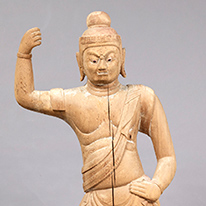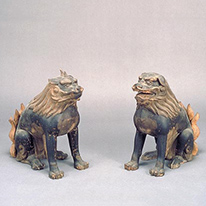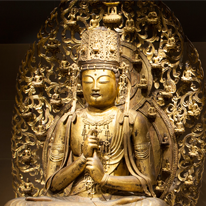Past Exhibitions
- Feature Exhibit: The Newly Conserved Standing Zaō Gongen Sculpture of Sanbutsu-ji Temple, Tottori
- January 17, 2017 - February 19, 2017
Mitokusan Sanbutsu-ji Temple, in the town of Misasa, is one of the most venerable temples in Tottori prefecture. It is said to have been founded during the Nara period in 706 by En no Gyōja, originator of the syncretic, mountain-worshiping religion of Shugendō. Its inner sanctuary, the Nageiro-dō Hall, is built on a sheer cliff face and is designated as a National Treasure. Numerous Zaō Gongen sculptures were formerly enshrined here (gongen means “incarnation” and is the syncretic concept of a Buddhist deity appearing in the form of a Shinto kami). Today seven of these, the temple’s main object of worship and six subsidiary statues, are kept in the Treasure Hall at the mountain’s foot. All are designated as Important Cultural Properties of Japan, and two of them were just restored at the Kyoto National Museum’s Conservation Center for Cultural Properties. Please take this rare opportunity to view one of them in this feature exhibit celebrating the completion of their conservation.
- Shinto Deities and Guardian Lions and Lion Dogs
- September 13, 2016 - October 2, 2016
One of the rituals of the Japanese New Year is the first shrine visit of the year, called hatsumōde. After passing through torii gates into the shrine, a visitor will usually come upon a pair of stone statues guarding the shrine entrance, comprising a lion (shishi) and a lion dog (komainu). Normally the sculpture on the right, with mouth open, is the lion. The one on the left, usually with mouth closed and often with a horn on its head, is the lion dog. In ancient and medieval Japan, these guardian lions and lion dog images were typically made not of stone but of wood, and they were placed inside the shrine buildings instead of outdoors. This exhibition features rare examples of early lions and lion dogs together with sculptures of the Shinto deities that they protect.
- Japanese Sculpture
- September 13, 2016 - October 2, 2016
Before the Edo period, almost all Japanese sculpture was religious in nature. Buddhist sculptures were produced in Japan from the time Buddhism took hold in the seventh century, but the icons they represented came from India by way of China, bringing with them the influence of those countries.
One of the distinctive characteristics of Japanese sculpture is its use of wood as a primary material. Because sculptures were made of wood, various construction styles and techniques were developed, including joint-block construction (yosegi zukuri) and inlaid crystal eyes.
Japanese Buddhist sculptures from various historical periods exemplify the repeated waves of influence from the Asian mainland and subsequent Japanese innovations, leading to a rich variety of sculptural styles.














